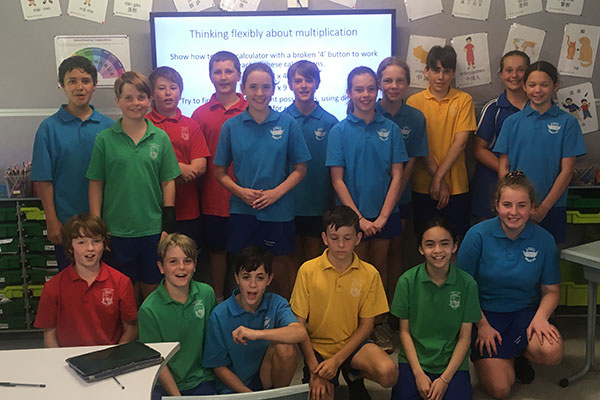Posted Tuesday, 20 May 2025
Scitech to spark science curiosity across the Kimberley
Scitech is embarking on an epic tour across the Kimberley, visiting 26 remote community schools.
Pete shares how his students gain a deeper understanding of maths strategy, rather than just rules to remember.

Hi ACoM Blog readers, this is Peter Cosgrove, year 6 teacher at St Joseph’s Catholic Primary School in Pinjarra, back with my second post. You can read my first one here.
This time I’d like to focus on describing a particular session to give you an idea of how the Champions of Maths program works in my classroom.
The aim of this session is to assess and deepen the children’s understanding of multiplication rather than seeing it merely as a procedure to be learnt.
The task is to show how to use a calculator with a broken ‘4’ button to work out each of these calculations: 634 x 4 and 434 x 9
 |
 |
As with each of the ACoM sessions, the launch phase as a whole class at the board is kept short and sweet with just a quick discussion about group norms. The point that children must be prepared to justify their arguments and have them justified is reiterated as it is central to meaningful maths discussions.
As a class, one target is for the children to endeavour to become more independent in interpreting the problem, so I have done little more than read the question through. Often children less confident in their maths ability, out of fear of getting it wrong, naturally want to discuss it with me before having a go. I am trying to wean them off this to encourage them to go for it, and after a time, I will then offer a prompt or assistance.
The first solution hit upon by Group A is based on ‘doubling and halving’ – so 634 x 4 becomes 1268 x 2 or 317 x 8 and 434 x 9 becomes 217 x 18.
It was one of the strategies I anticipated but nevertheless I am pleased as it is not a strategy that we have put much focus on in class. To me, it demonstrates a sound understanding of the meaning of multiplication and how it works.
With mental maths for the lower ability children, I have been wary of giving them too many different strategies which could be confusing to choose when to apply them and when not to. Sessions like these are invaluable in giving them a lot of time on one problem to play around with the numbers and explore the relationship between those numbers. A deeper understanding of a strategy is therefore encouraged rather than just another maths strategy with rules to remember.
Group C uses addition to solve the problem. 633 +1 + 633 + 1 + 633 + 1 + 633 + 1
Again, this was one of the anticipated strategies and demonstrates a clear understanding of multiplication as repeated addition. Other groups do various slight variations of the same strategy.
Another solution is provided by Group B: (600 x 2 x 2) + (31 x 2 x 2) + (3 x 2 x 2) This solution demonstrates that the children once again have a very clear picture of the nature of multiplication. We have been working recently in class on ‘Order of Operations’ so we had a subsequent class discussion about the necessity of brackets. The other groups, after a ‘turn and talk’ agreed that Group B had used brackets correctly here.
As in other sessions, this problem pulls together a variety of maths learning objectives and again demonstrates to the children the interconnectivity of maths.
I have personally found in these problem-solving sessions that the strong emphasis on identifying solution types and possible misconceptions beforehand is valuable.
As maths teachers, we are generally ready for the familiar misconceptions with particular learning objectives or strategies. Nonetheless, I am probably now thinking more deeply ahead of my day to day maths lessons about how the children will approach a task – and that has to be a good thing!
These sessions have also reinforced my belief in the importance of ‘the struggle’ in maths. Returning again to the less confident children in the class, they can often seem to grasp a topic but then, when presented with it in a problem-solving situation, they are nonplussed. The grasp is revealed to be insecure. However, with regular exposure to a range of problems in which they have to apply their knowledge, that understanding is deepened.
An aspect of the Champions of Maths project I have particularly enjoyed is the discussion and exploration of the subject with colleagues. As a teacher in a one form school, and not having a colleague in my year group, I am now more aware of my personal responsibility to engage with and participate in teacher forums to tap into the wealth of knowledge of colleagues out there.
Signing off from this last blog, I’d like to thank Shyam, Scitech and the other teachers involved in the Champions of Maths project. I thoroughly recommend it to all teachers looking to improve their understanding and teaching of maths.
Find out more about the Alcoa Maths Enrichment Program.
Would you like to continue a discussion on this topic with other educators? Join our Facebook group!
If you are interested in joining the Alcoa Maths Enrichment Program please fill out the enquiry form below and a Scitech representative will be in touch with you.
Upon clicking the "Book Now" or "Buy Gift Card" buttons a new window will open prompting contact information and payment details.